Art World
The Endurance Test of Lucy Bull’s Visceral Abstractions
Lucy Bull creates psychedelic abstractions that collectors can't get enough of. Meanwhile, the artist is testing her own limits.
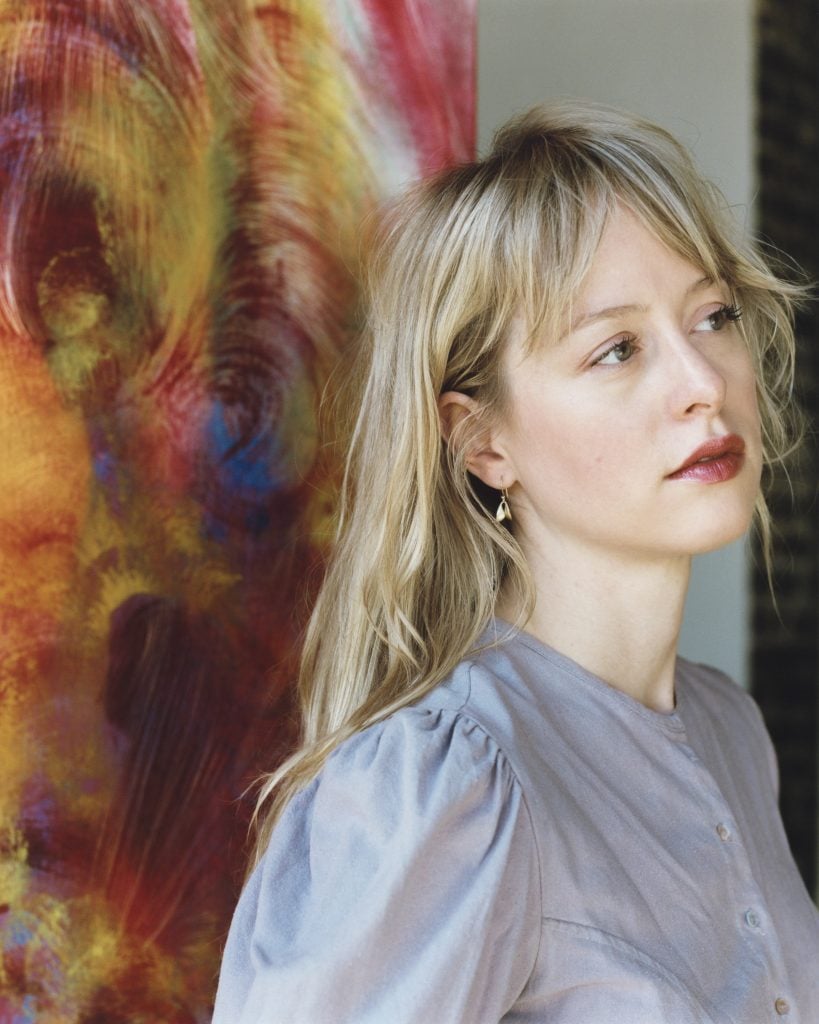
Lucy Bull paints like an athlete. The 34-year-old Los Angeles-based artist is all about endurance. “I work for long stretches of time. Sometimes I have to work all day to get to a place where I’m feeling loose and tapping into the right head space,” she said, on a recent call from her home. “Some days, I’m just laying out all this paint that I’m going to completely obliterate the next day.”
Bull isn’t exaggerating. She paints riotous, elemental, often colossal canvases in a deeply physical process, accruing layers and layers of paint of time which she then etches into, revealing earlier passages. Bull moves rhythmically between paintings, always working on multiple canvases. “It’s a dance between more compulsive, spontaneous mark-making and reflective sort of teasing out of various associations,” she said, “Then I go back in with more automatic painting. Eventually, the older layers start to act as a relief. It becomes this interwoven experience of surprising landscapes or dreamscapes.”
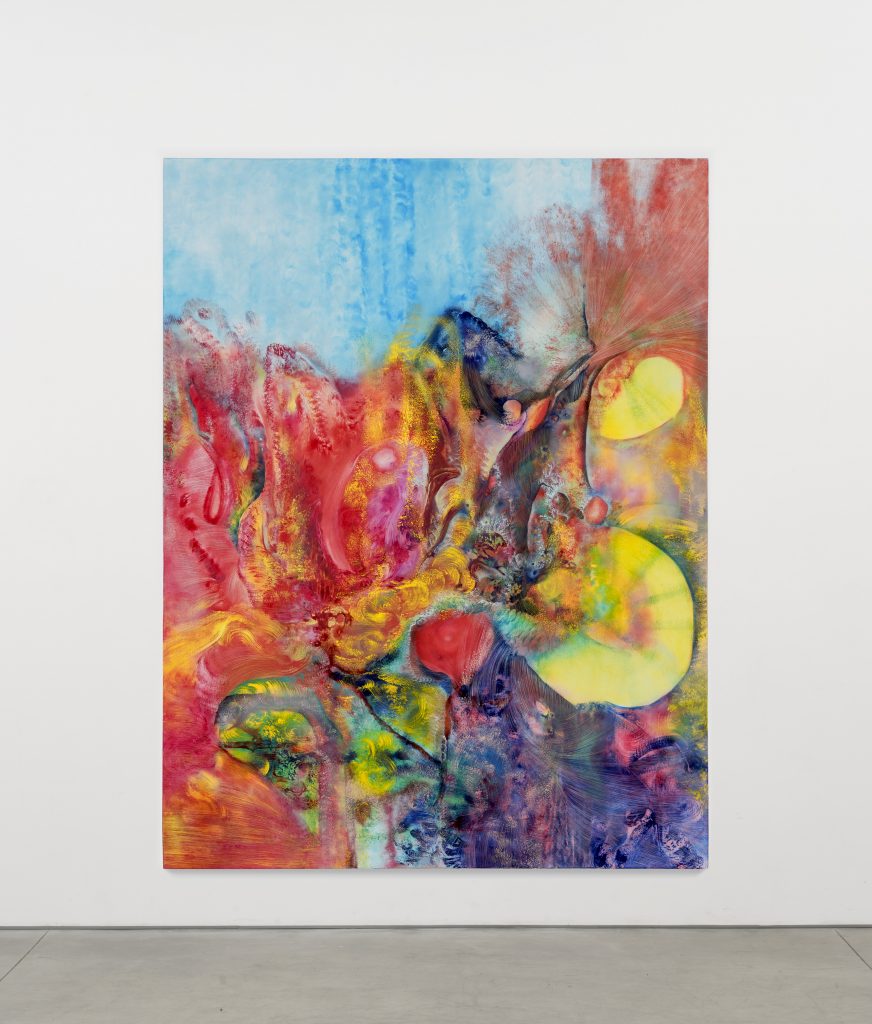
Lucy Bull , 4:28, 2024. Photo: Elon Schoenholz, courtesy of David Kordansky Gallery
The work is rigorous and intuitive and can take months to create. The process she works with is called frottage and it’s one Bull shares with one of her art historical heroes, Max Ernst, who used it to create his haunting Surrealist landscapes. “He used frottage, this process of layering and revealing, as a means of accessing the subconscious,” she explained.
Her paintings—which collectors can’t seem to get enough of—aren’t without psychological resonance either. Colors—teals, oranges, hot pinks—drench these canvases, forming whorls and eddies that, in moments, hover at the threshold of recognizability before cresting and crashing down into abstract oblivion. “They’re similar to Rorschach tests,” she explained, “What people see or even their favorite painting in a show is like having a glimpse into someone’s mind and how they relate to the world.”
Bull was speaking to me days after opening “Ash Tree,” her third exhibition with the gallery David Kordansky. The show is a follow-up to her previous Kordansky exhibitions “Skunk Grove” in Los Angeles in 2021 and “Piper” at its New York outpost in 2022 (she joined its roster in 2021 and has quickly become a star of the gallery’s programming). For Bull, the exhibition was a chance to fully flex her artistic muscles.
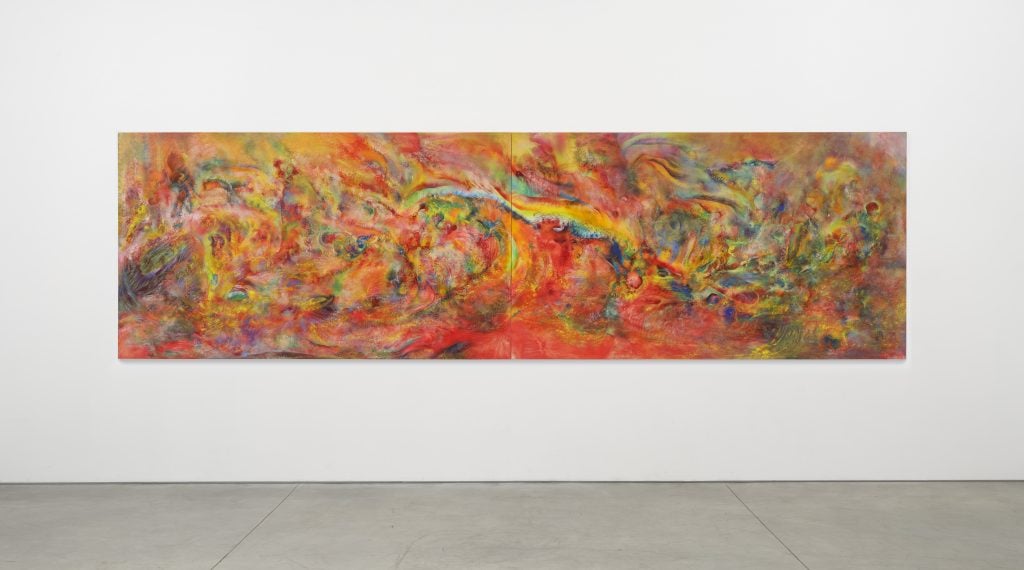
Lucy Bull , 3:13, 2023. Photo: Elon Schoenholz, courtesy of David Kordansky Gallery
The past few years have been a whirlwind of exhibitions and fairs. Bull has also held institutional shows at the Warehouse Dallas, as well as the Long Museum in Shanghai in 2023. Collectors, meanwhile, have been clamoring for her works. Paintings less than five years old have been bid to stratospheric prices at auction. Forty of Bull’s works have come to auction since 2022, according to Artnet’s Price Database, with an impressive 84 percent sell-through rate and 63 percent of works exceeding their estimates.
The ascension shows no immediate signs of slowing. At Sotheby’s earlier this month, Bull’s painting 16:10 (2020) sold for a staggering 1.8 million, 159 percent of its estimate in the Now Evening Auction, breaking a previous record of $1.7 million for her 2020 painting Flash Chamber set at Sotheby’s Hong Kong last October. Next week, her painting Claps Jaw (2019) is heading to the block at Phillips Hong Kong with a presale estimate of $2.8 to 3.5 million HKD (approximately 360,000 to 450,000 dollars).
Amid this market noise, “Ash Tree” is a moment of return to home base for Bull, who decidedly keeps her focus elsewhere. Her newest work, she says, is deeply personal. “I think of the show as holding death and rebirth in two parts,” said Bull, “I went through a huge breakup since working on this show and something about the title ‘Ash Tree’ felt right and weird to me. Ash returns to the ground while a tree grows up.”
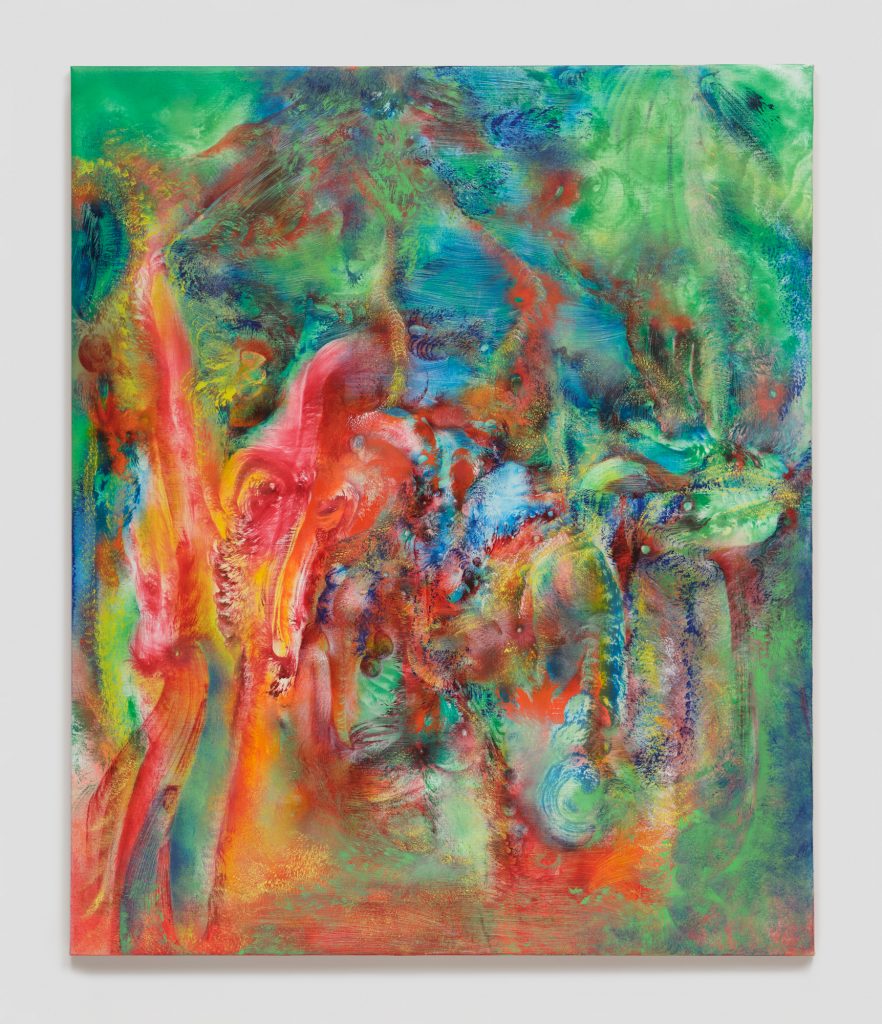
Lucy Bull , 14:01, 2024. Photo: Elon Schoenholz, courtesy of David Kordansky Gallery
The paintings shift from warm oranges and reds (works she began earlier in the process) to cooler and darker hues, of blues and greens (her more recent works). She refers to the paintings as “litters” and while she does see synergies between specific paintings, she doesn’t expect others to see them. Her hopes for her paintings are more experiential. “I want to titillate the senses, I want to draw the viewer in and create something that hopefully they can get lost in. The more time you spend in front of the painting, the more it transforms,” she said “It’s important to me that a painting constantly provides new entry points.”
East Coast Origins
Bull was born in New York, the child of two creatives. Her mother is a painter and a video and multimedia artist. She designed textiles when Bull and her sister were growing up. Her father is a documentary filmmaker.
“My dad was an assistant to Manny Farber, the painter and film theorist,” Bull said. Though her parents had tried to steer Bull toward a more generalized liberal arts education, she was stuck on painting. After enrolling at the Rhode Island School of Design (and flirting with the idea of working in fashion), Bull transferred to the School at the Art Institute of Chicago, returning to New York after graduation.
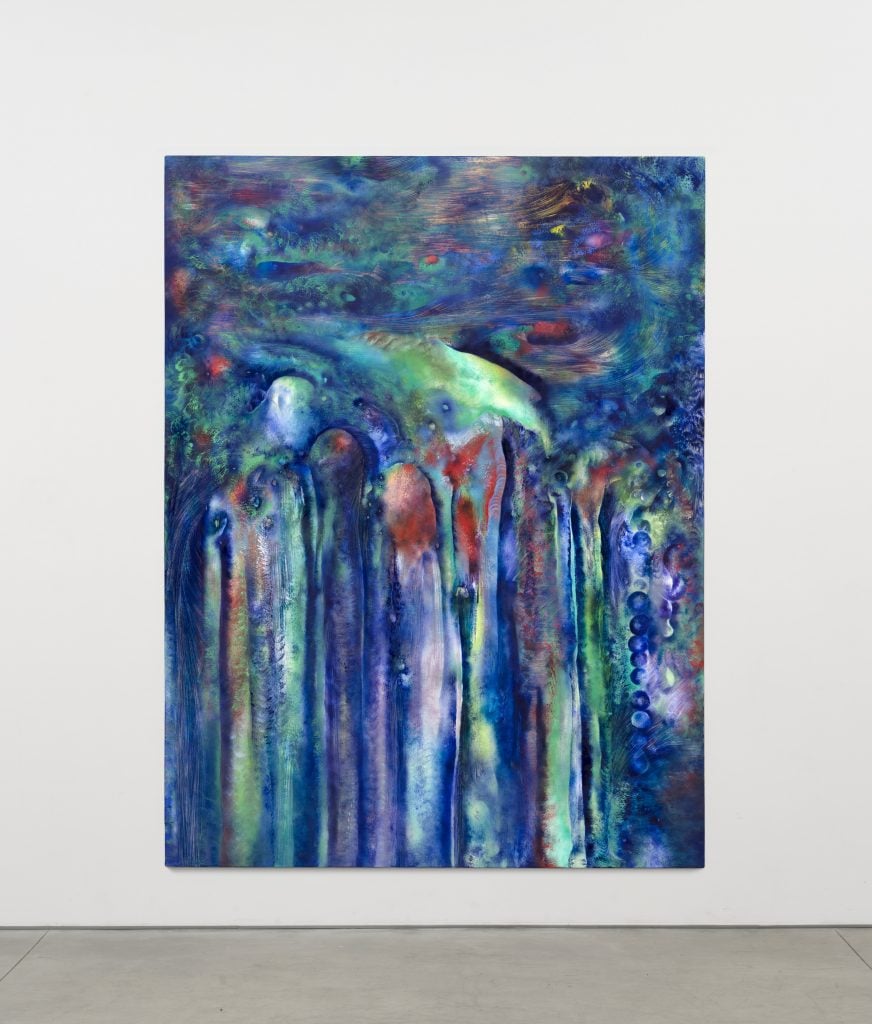
Lucy Bull , 15:17, 2024. Photo: Elon Schoenholz, courtesy of David Kordansky Gallery
A boyfriend would eventually lead Bull to Los Angeles, the city that would form her artistically. “He had spent a lot of time in New York and was tired of it and wanted to move to L.A. And I was just curious. I’d never lived on the West Coast,” Bull recalled. The boyfriend happened to be Matt Mullican’s studio manager at the time. “In a way, it was a huge part of my evolution—the proximity to the Mullicans and Luchita Hurtado, Matt Mullican’s mom. She had the most amazing stories—Duchamp massaging her feet at the party and how she used to get martinis with Agnes Martin. Agnes Martin used to walk backward, and Luchita would tell people not to make fun of her and things like that.”
In L.A., the boyfriend became involved with the estate of Lee Mullican, which proved pivotal to Bull. “Lee Mullican is the painter’s painter. He created his own process, using the pallet knife. Being around his work made me realize, ‘Oh, I need to find my process.’” Bull began using her brushes, and with them, her body, untraditionally, while painting in a nearly monochromatic palette.
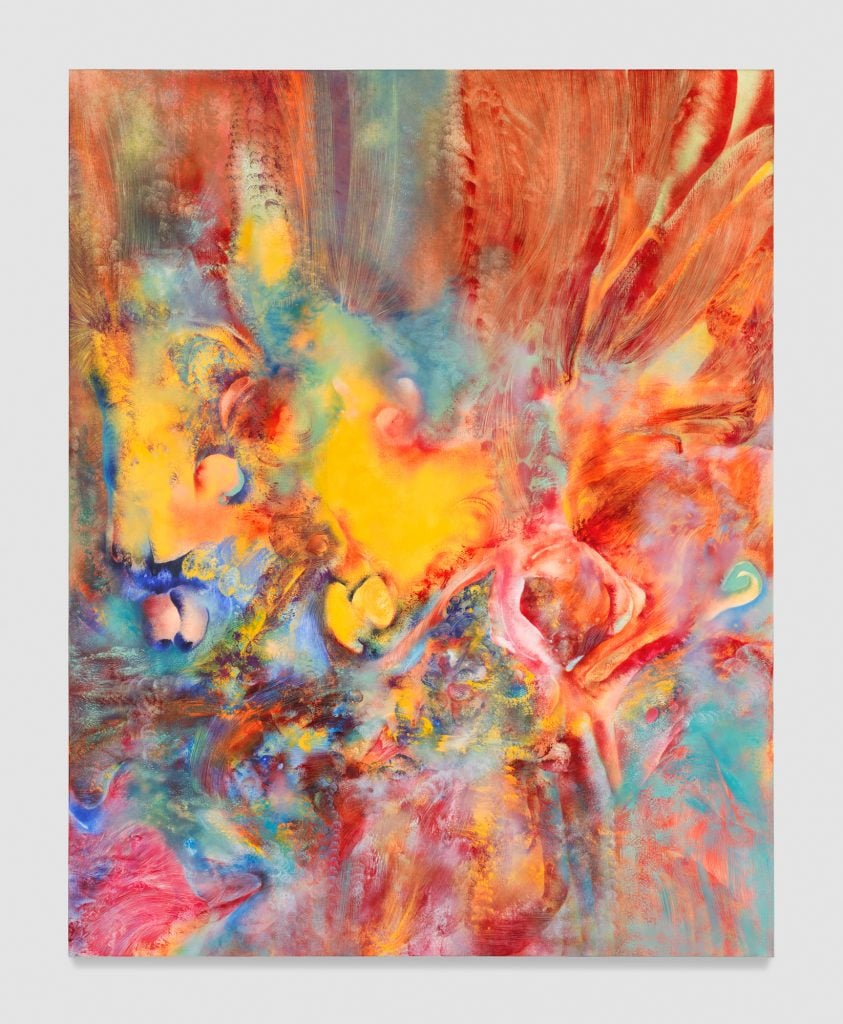
Lucy Bull , 16:23, 2024. Photo: Elon Schoenholz, courtesy of David Kordansky Gallery
“I was trying to expand my vocabulary of marks with a single brush, splaying the bristles or using the tip of the brush so that I was stamping with the brush or imprinting with the bristles. I was using various wrist flicks or different speeds to make different marks. Eventually, I introduced color into the mix and that’s when I started to be able to layer it more and the depth opened up. I had found a way to stretch out the process to leave room for this discovery,” she explained.
Los Angeles, she says, has everything to do with her sense of color. “I fell in love with the light and the flora and fauna here,” she noted, a ring of happiness in her voice, “There’s something about the sun in Los Angeles and how it bleaches everything out. You can wear tons of colors here. You can make these crazy paintings that assault the senses.”
Experiments and Endurance
The community Bull found in Los Angeles was arguably just as influential as the landscape. Working as a waitress, living paycheck to paycheck, Bull decided to take a chance and open up her home with a curatorial experiment—a series of tabletop exhibitions called “From the Desk of Lucy Bull.” Bull invited artists she knew and friends of friends to stage exhibitions on a desk in her house. The practice brought a mix of creatives into her home—and gave Bull good insight into her work, too. “I used to be overly protective of works in progress. Letting people come in and see my work—well there is something more exciting about meeting people in the privacy of your own home,” she laughed.
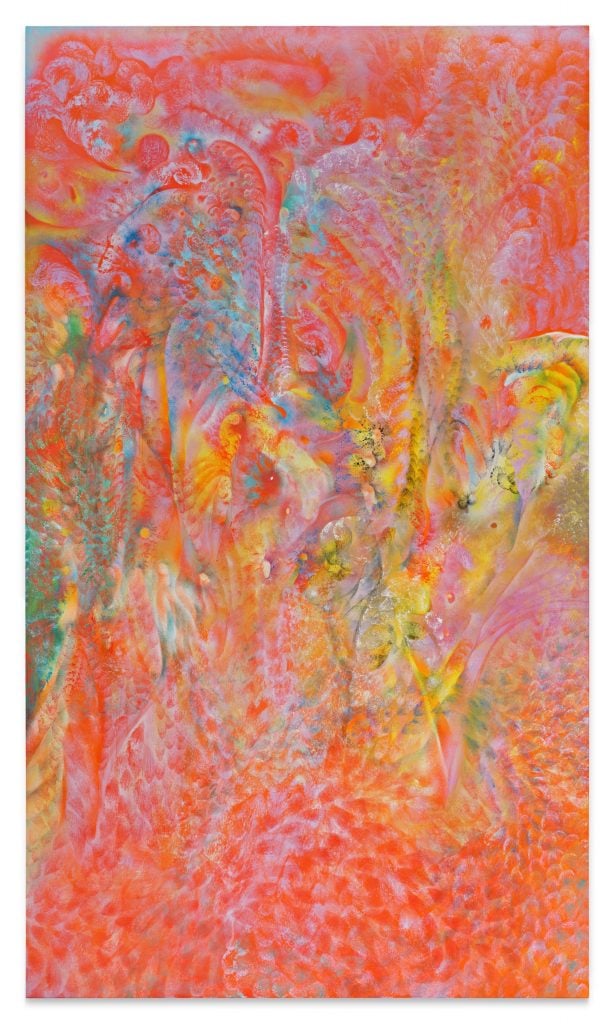
Lucy Bull, 16:10 (2020). Image courtesy Sotheby’s
Soon enough, these curatorial projects moved beyond her domestic sphere, even on the road at one point. “I did this cool project where I invited the artist Alexandra Metcalf to install work in my Prius, and she made this chandelier sculpture and pimped out my ride,” she said. “What gets more intimate than a car in L.A.?” Bull says these curatorial endeavors built her community and put her on the map of other artists. “It’s part of my story. It became this other layer of collapse,” she said.
Bull’s artistic social experiments are far from over. On June 1, she’s staging a 24-hour non-stop movie marathon at Lumiere Cinema in Beverly Hills. This is the second one she’s organized, the first was in 2019, coinciding with the unveiling of a lightbox painting she’d made for the facade of the nonprofit Human Resources, which is housed in a former adult cinema.
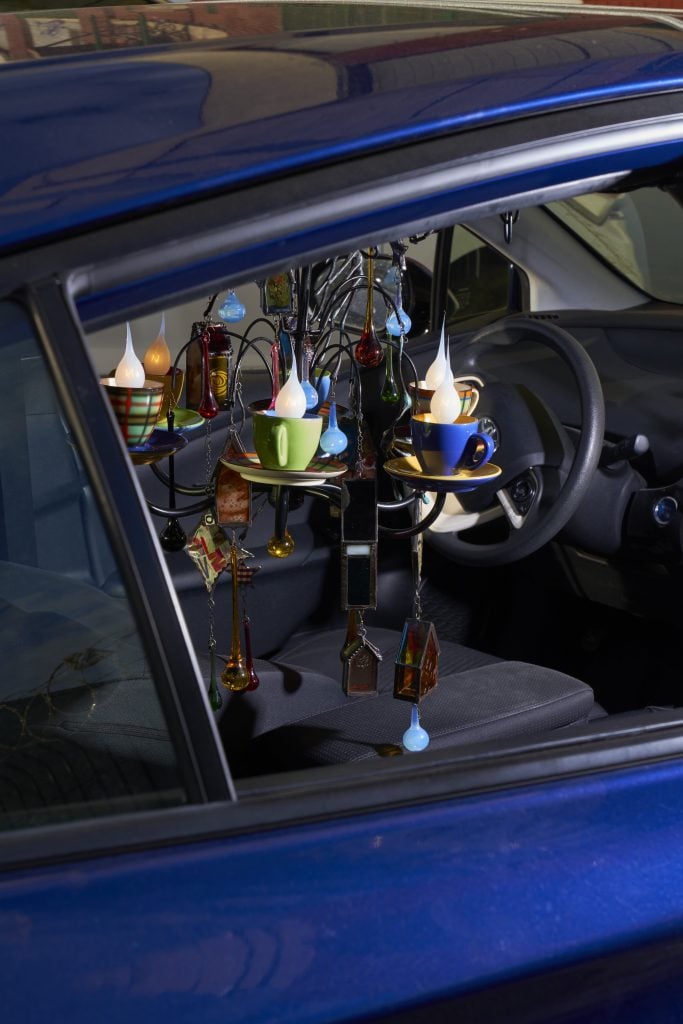
Alexandra Metcalf’s installation in Bull’s car. Photo by Jackson Hallberg. Courtesy of the artist
Movies are just one more form of endurance training for the artist. “I am interested in torquing the energy. I imagine the viewers treating this as a real marathon, and who might start to get tired at some point…maybe the imagery mirrors how they feel, it starts to get soggy,” she said. She will be screening films by Pedro Almodóvar, Hideaki Anno, Jean Cocteau, David Cronenberg, Jon Rafman, and Tsai Ming-liang, among others.
“I’m interested in this as an exercise in indulgence. You’re left with an impression from one film which might bleed into the next. Everything starts to collapse, creating this new experience where your perceptions are completely altered,” she said “That’s how I think about painting, creating this experience that you can feel your way through. No matter what I do or what medium I’m working in, it’s always through the lens of painting.”





